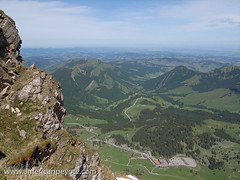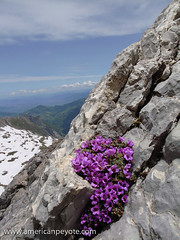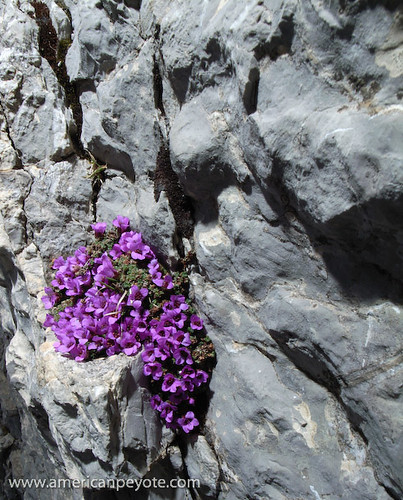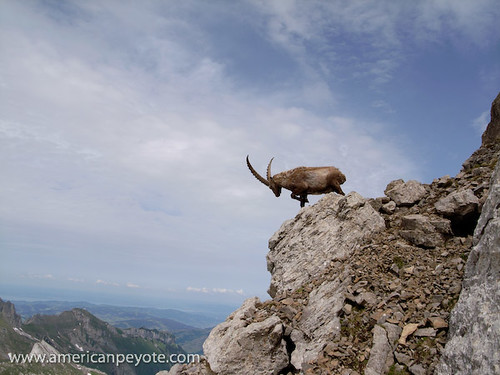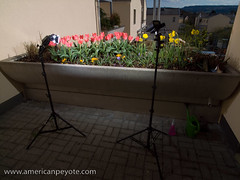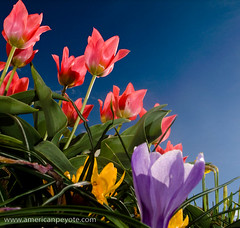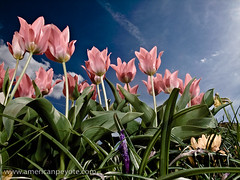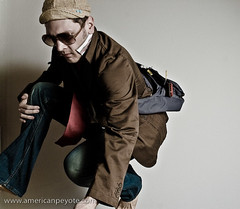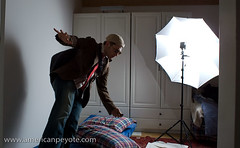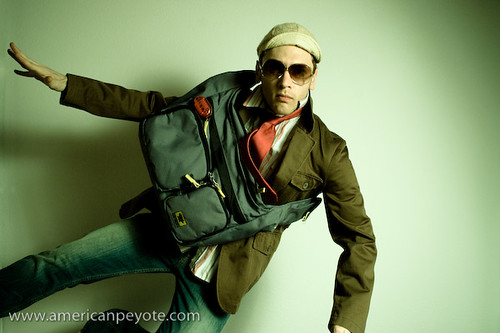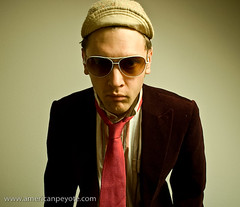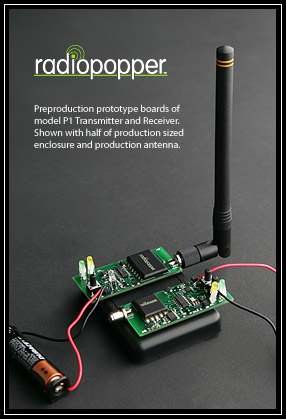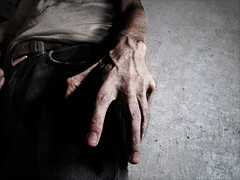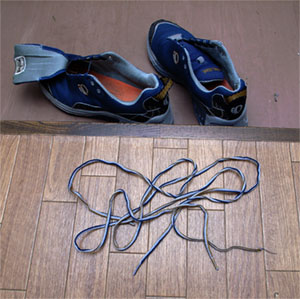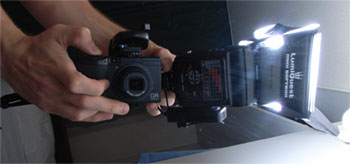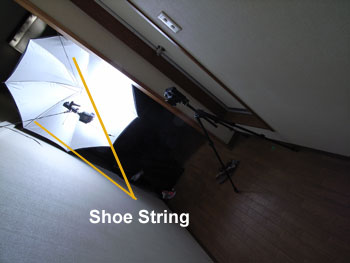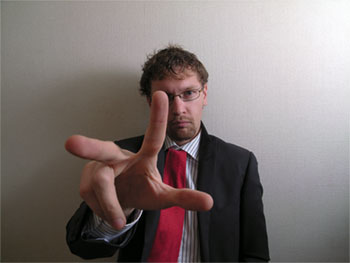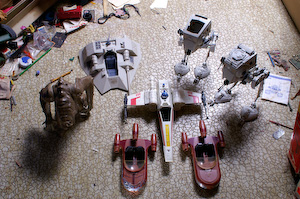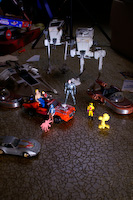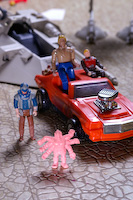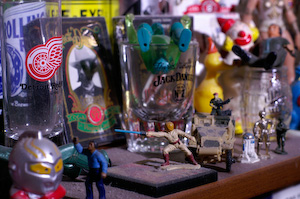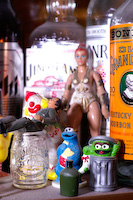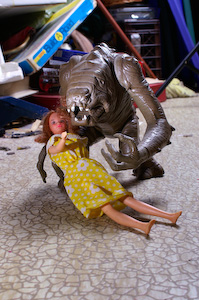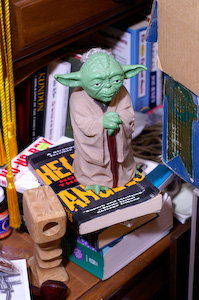 There are probably very few reasons to walk through a Swiss train station with a sword slung around your body. Even if you are a Ninja, in modern times the Katana offers little to the needs of a hired killer, except to show-off and behead a target if paid to do so. If you’re a photographer en-route to a Swiss Strobist meetup however, it makes perfect sense, and is even acceptible in some ways, to casually stroll through the Bern train station with a Katana slung over your shoulder and a Kacey beauty dish under your arm. It’s unclear to me, the actual legalities of walking around a Swiss train station with a Katana slung over the shoulder. So it’s best to bungy a light stand to the Katana after wrapping in olive green farbic, now when you’re stopped by die Polizei you can say something like, “Ah, das is nur eine Blitz Stative.”
There are probably very few reasons to walk through a Swiss train station with a sword slung around your body. Even if you are a Ninja, in modern times the Katana offers little to the needs of a hired killer, except to show-off and behead a target if paid to do so. If you’re a photographer en-route to a Swiss Strobist meetup however, it makes perfect sense, and is even acceptible in some ways, to casually stroll through the Bern train station with a Katana slung over your shoulder and a Kacey beauty dish under your arm. It’s unclear to me, the actual legalities of walking around a Swiss train station with a Katana slung over the shoulder. So it’s best to bungy a light stand to the Katana after wrapping in olive green farbic, now when you’re stopped by die Polizei you can say something like, “Ah, das is nur eine Blitz Stative.”
The Swiss Strobist meet-up in Bern was organized by Mark Howells-Mead. Traveling under the name Permanent Tourist on the net, he’s an aspiring photographer who’s taken some initiative to organize photographers in Switzerland around the Storbist philosophy of location shooting. I know Bern fairly well, but I’d never shot there, and when you’re presented with an option of staying in bed or jumping on a train to Bern with your Katana, the word “Yes” should dominate any other suggestion in your head at 6:30am on a Sunday morning.
Why take a Katana to a Strobist meetup? Mark said he was impressed by the Ninja shots from Chase Jarvis and my Urban Ninja images, and asked if I could swing by with my sword, as he had some idea of executing a modern Jack the Ripper photo on the streets of Bern. It seemed like a reasonable request, so I agreed to head to head to Bern on a fine Sunday morning for the Strobist meet-up. I had other motives of course, for me das Ziel of the day was to fool around with my new fantastic lighting combiation, a Kacey Beauty Reflector with a Sunpak 120J powered by a TR-II battery pack. Beautiful light, power, and long battery life in a mobile configuration. I’d just received a Kacey dish the week before and shot with it in my apartment. I love the light from the Kacey dish, and wanted to try it out on a location. So when my alarm went off around 6:30am, I set about collecting my things for the day. Minolta 7D, Canon G10, Kacey reflector, light stand, Doc Martens, Katana, Bratz doll…let’s roll.
The format of the Bern Swiss-Strobist meet-up was a bit more structured than I’m used to at these things. In the morning we broke up into groups including a model with a leader to run the shoot, then in the afternoon it was a free-for-all with photogrphers shooting models and experimenting. This offered a nice mix, letting some photographers teach, with the option of getting more interactive in the afternoon. The best way to learn with flash is just to do.
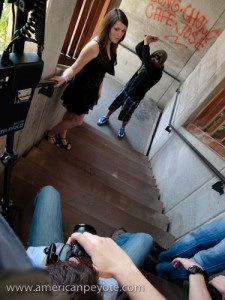
The Kacey Dish on Location
The Kacey dish is large. I realized this when a giant box was given to me by the nice woman at my local post office. I had ordered the dish along with the Kacey location bag. I figured, what the hell, if I don’t buy the bag I probably won’t take the dish with me when I leave my apartment, and that would a be a shame. The Kacey dish is marketed as a small-flash beauty dish, ideal for people like myself, who primairly uses small flashes and loves the idea of shooting with a dish.
The Kacey dish is actually very enjoyable to travel with. I took the train from Winterthur to Bern, and then walked around, went on a bus, walked around some more, did some shooting, walked around, blah, blah, blah. At the end of the day I was still skipping along the streets of Bern like a woodland creature from Narnia with my Kacey dish slung over my shoulder. I have no complaints on mobility. Even though the dish looks large and heavy, it’s rather light for what it is and travels extremely well. The Kacey reflector is made from plastic, no doubt some impact resistant formulation formed via an injection molding process. Is it a good idea to mold a beauty dish out of plastic instead of aluminum? Yes, without a doubt. As a Doctor of Science with a Master’s in Materials Science, I have full confidence in the durability and strength of the Kacey reflector, and plan to be using it till I loose interest in photography, or die.
I carried the Kacey dish with the optional bag, as a sometimes avid world travler and mountineer, I’ve developed sort of a bag fetish over the years. My adventure equipment room is stocked with everything from North Face to Lowe Alpine summit packs, multiple Mountain Smith lumbar designs, a Go Lite here, a Mammut there, and my favorite all around climbing/ski touring/mountaineering bags; my Osprey Exposure packs. I know packs, and from a materials standpoint I look for durability in the fabric and robustness in the zippers. The Kacey dish bag is no bullshit, one of the most well-made, highest quiality bags I’ve ever used for anything. The quaility of the $85 Kacey bag is bomb-proof, the stitching is exact, the materials are robust, and the zippers even surpass those on my North Face basecamp duffles.
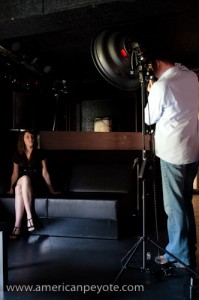 Swiss Strobists and the Kacey Dish
Swiss Strobists and the Kacey Dish
So, how did the dish perform, how was it received by the Swiss Strobists? Our first shoot was in the Wasserwerk, an industrial site-turned hip nightclub (like many nightclubs in Winterthur, Zurich, and Bern). Mark was trying to light the fully black interior of the club with our model Rahel sitting on a black lounge couch and some Nikon speedlights. Mark had been to the Strobist Cern Workshop, and he started to channel David Hobby, running around the place setting up a flash here, an umbrella there, taking test shots, checking the exposure…then we setup the Kacey dish with my Sunpak 120J (we later switched to one of Mark’s Nikon SB-something flashes so he could use his radio triggers).
I remember Mark saying something like (no, I’m not sure of the exact quote), “Wow, I don’t really need all these flashes, the light is just so perfect already.”
Yes, umbrellas are cheap and great, but nothing beats the light from a nice dish like the Kacey reflector. That’s why people like to use them, they just work, they produce beautiful light without much stress on the part of the photographer. Mark seemed to be impressed by the Kacey reflector, so much so that it was used as the main lighting source on the first two shoots of the day (including his new-age Jack the Ripper shot). He might have used it in the afternoon as well, but I took it back and was able to get a few shots with one of our other models, Sarah before my battery pack died.
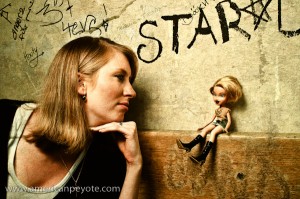
Shooting Sarah with the Kacey Dish
In the afternoon we photographers had a free-for-all setting up shots in various places. I chose to work with Sarah. I’d taken a Bratz doll with me (I take at least one every time I pack up my camera gear now) and had some ideas. I keep expecting people to look at me like a crazy person when I pull out a camera and Bratz doll, but everyone on the streets are continually amused at my antics. Sarah and I set up near the Aare, the river running through Bern. We were in a small alcove area, with a beautiful view of the river and some nice graffiti on the walls of the old city. I posed Sarah with and without a blonde Bratz doll. Sometimes I threw it up in the air, sometimes I just posed them against one another.
The Kacey dish was used on a light stand, and I leaned it in closer as needed to fine-tune the light. In the first setup the Kacey dish was acting more as a large light source from above Sarah, and the light here would probably be similar to that of an umbrella. I was able to get some nice light fall-off, lighting both Sarah and the Bratz doll with nice, even light. Soft yet directional, and was able to get a nice exposure on the wall as well, where you can see the fine texture near the graffiti.
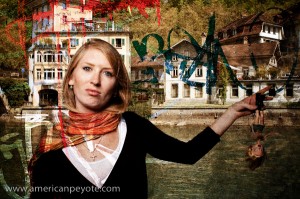 I also posed Sarah against the backdrop of the city in the sun, and bumped up the power on my 120J to balance Sarah’s exposure with that of the background. I was able to get that fine type of light fall-off on Sarah’s face that I love, the type where the face has an even exposure and then the shadows just lightly surround the face. This is exactly why I bought the Kacey reflector, to get those fantastically beautiful shadows with the ability to move and direct the light to where I want it. It’s not something I can easily do with normal umbrellas, and is the reason the Kacey dish is now my favorite light modifier. For the post-processing I went with a graffiti grunge feel, high-lighting the natural graffiti of the walls, or combining Sarah with graffiti overlays from Zurich which I had shot earlier.
I also posed Sarah against the backdrop of the city in the sun, and bumped up the power on my 120J to balance Sarah’s exposure with that of the background. I was able to get that fine type of light fall-off on Sarah’s face that I love, the type where the face has an even exposure and then the shadows just lightly surround the face. This is exactly why I bought the Kacey reflector, to get those fantastically beautiful shadows with the ability to move and direct the light to where I want it. It’s not something I can easily do with normal umbrellas, and is the reason the Kacey dish is now my favorite light modifier. For the post-processing I went with a graffiti grunge feel, high-lighting the natural graffiti of the walls, or combining Sarah with graffiti overlays from Zurich which I had shot earlier.
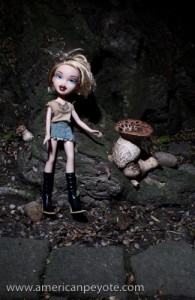 So, brass tacks – the Kacey Beauty Reflector is light and nimble on location. I love the light from it, use a bare-bulb 120J, or just a traditional Nikon SB (or a similar design), and you just get fantastic light. No mess, less fuss, excellent light and you direct it where you want it. An enthusiastic thumbs-up, a vigorous affirmation of my affection for the Kacey dish. Now I just need to get it mounted for my in-the-mail Elinchrom BxRi flashes. If you ever find yourself in Bern and happen to look down only to find a Bratz doll standing next to a giant magic mushroom, don’t be alarmed, this is simply the natural order of things in the Universe, and if you keep looking, you’re sure to find stranger things along the path in this life or the next.
So, brass tacks – the Kacey Beauty Reflector is light and nimble on location. I love the light from it, use a bare-bulb 120J, or just a traditional Nikon SB (or a similar design), and you just get fantastic light. No mess, less fuss, excellent light and you direct it where you want it. An enthusiastic thumbs-up, a vigorous affirmation of my affection for the Kacey dish. Now I just need to get it mounted for my in-the-mail Elinchrom BxRi flashes. If you ever find yourself in Bern and happen to look down only to find a Bratz doll standing next to a giant magic mushroom, don’t be alarmed, this is simply the natural order of things in the Universe, and if you keep looking, you’re sure to find stranger things along the path in this life or the next.
?
?
?
Shooting with the Kacey Dish in my apartment Studio
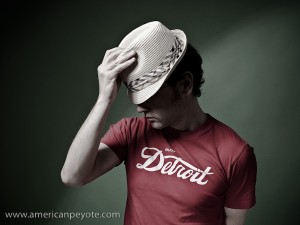 I picked up the
I picked up the 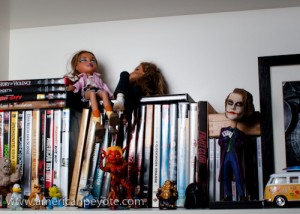 My first experience with the Kacey dish was photographing my bookcase, complete with Bratz dolls, DVDs and an assortment of toys from California because, well – I’m a geek. What was I expecting and why did I want a beauty dish in the first place? Well, I like umbrellas for throwing a very large amount of light with spill going in all directions, I started using reflective and shoot-through umbrellas, and they have their place. When you’re starting out with lighting design, it’s the best way to go. Umbrellas are cheap, you can get a combined reflector-shoot-through design and it’s very easy to do basic lighting with an umbrella. But, they then become very limiting when one wants to start doing more precise lighting. To explore beyond the umbrella I bought some small softboxes in order to increase the precision of my lighting designs, because they are much more versatile than my 44in umbrellas. The softboxes can be placed on a boom, to the side, behind, where ever I desire around whatever it is I’m photographing. Umbrellas (at least the large ones I have) are not as easy to place, and give too much light spillage for my tastes. Softboxes can be gridded to further decrease light spill and sculpt light as one desires. However, the softbox creates a more diffused light source. What I wanted to achieve with a beauty dish is the ability to place harder light in a desired position. I like the look of photos I’ve seen with beauty dishes, and really I wanted the ability to place a large, even light source on a boom arm around models (ummm, and I’m generally the model). The Kacey dish represents a milestone for me, because it’s the first light modifier I’ve purchased which wasn’t made in China and bought because it was the cheapest option.
My first experience with the Kacey dish was photographing my bookcase, complete with Bratz dolls, DVDs and an assortment of toys from California because, well – I’m a geek. What was I expecting and why did I want a beauty dish in the first place? Well, I like umbrellas for throwing a very large amount of light with spill going in all directions, I started using reflective and shoot-through umbrellas, and they have their place. When you’re starting out with lighting design, it’s the best way to go. Umbrellas are cheap, you can get a combined reflector-shoot-through design and it’s very easy to do basic lighting with an umbrella. But, they then become very limiting when one wants to start doing more precise lighting. To explore beyond the umbrella I bought some small softboxes in order to increase the precision of my lighting designs, because they are much more versatile than my 44in umbrellas. The softboxes can be placed on a boom, to the side, behind, where ever I desire around whatever it is I’m photographing. Umbrellas (at least the large ones I have) are not as easy to place, and give too much light spillage for my tastes. Softboxes can be gridded to further decrease light spill and sculpt light as one desires. However, the softbox creates a more diffused light source. What I wanted to achieve with a beauty dish is the ability to place harder light in a desired position. I like the look of photos I’ve seen with beauty dishes, and really I wanted the ability to place a large, even light source on a boom arm around models (ummm, and I’m generally the model). The Kacey dish represents a milestone for me, because it’s the first light modifier I’ve purchased which wasn’t made in China and bought because it was the cheapest option.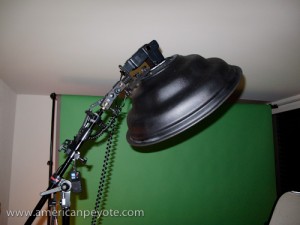 So, how has the Kacey Beauty Reflector fulfilled my desires so far? First, I’ll note that this review is user, not scientific based, and focuses on my experiences using the reflector in the controlled studio environment of my apartment. The Kacey reflector was designed for location use in mind, but light is light and I was most interested in getting an excellent light modifier. Naturally, any light modifier is useless without light from a quality strobe. The Kacey dish is designed with the Speedlite in mind, like those standard uber expensive flashes from Nikon and Canon, which a person such as myself with a Minolta 7D finds to be over-kill. This is all well and good to design a dish for small flashes, but beauty dishes were originally designed with studio strobes in mind, those with bare bulbs instead of a fresnel lens to focus the light beam, like nearly all small flashes have. Nearly all, but I happen to love the Sunpak 120J bare-bulb cult-classic flash, and it fits perfectly with the Kacey Beauty Dish. Here’s why, most small flashes are designed to focus light directly forward of the flash head. A bare-bulb design throws light forward as well to the side of the head. So when you use a normal Speedlite in a beauty dish, you generally would also use a diffuser on the flash, to throw light to the side of the center reflector of the dish. This spreads out the light and would logically contribute to the nice uniform quality of light that beauty dishes are known for. Since the bare-bulb 120J already is throwing light in all directions, and the bulb is extending into the dish, it forms the perfect lighting combination.
So, how has the Kacey Beauty Reflector fulfilled my desires so far? First, I’ll note that this review is user, not scientific based, and focuses on my experiences using the reflector in the controlled studio environment of my apartment. The Kacey reflector was designed for location use in mind, but light is light and I was most interested in getting an excellent light modifier. Naturally, any light modifier is useless without light from a quality strobe. The Kacey dish is designed with the Speedlite in mind, like those standard uber expensive flashes from Nikon and Canon, which a person such as myself with a Minolta 7D finds to be over-kill. This is all well and good to design a dish for small flashes, but beauty dishes were originally designed with studio strobes in mind, those with bare bulbs instead of a fresnel lens to focus the light beam, like nearly all small flashes have. Nearly all, but I happen to love the Sunpak 120J bare-bulb cult-classic flash, and it fits perfectly with the Kacey Beauty Dish. Here’s why, most small flashes are designed to focus light directly forward of the flash head. A bare-bulb design throws light forward as well to the side of the head. So when you use a normal Speedlite in a beauty dish, you generally would also use a diffuser on the flash, to throw light to the side of the center reflector of the dish. This spreads out the light and would logically contribute to the nice uniform quality of light that beauty dishes are known for. Since the bare-bulb 120J already is throwing light in all directions, and the bulb is extending into the dish, it forms the perfect lighting combination.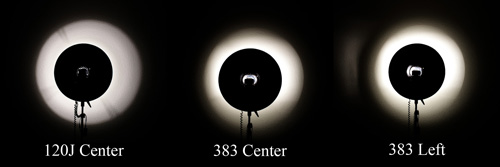
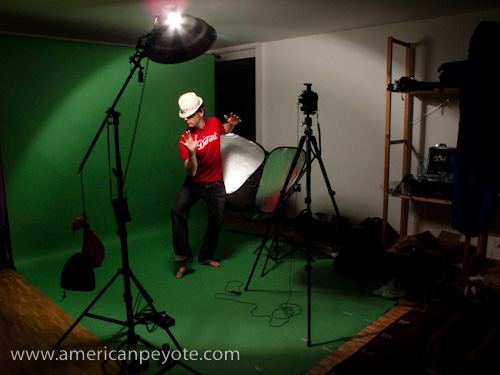 I ran a few test shots with myself playing the role of photographer, model, and art director, which feeds all the different parts of my creative brain. I wanted to get a feeling for the light I could expect from the Kacey Beauty Reflector both from a lighting and post-processing perspective. The setup was pretty basic, the dish went on a boom with the 120J above me and I setup my Lastolite Tri-Lite reflectors to get some fill. I did a few shots with my Minolta 7D and 28mm lens, Gadget Infinity radio triggers were used as well. I wore a shirt which says, “Enjoy Detroit,” because red is my color when shooting on a green background and Detroit is my city of eternal inspiration. I wore a hat I bought on the beach in San Diego and for some reason decided that the Katana would add a much needed element to the mix.
I ran a few test shots with myself playing the role of photographer, model, and art director, which feeds all the different parts of my creative brain. I wanted to get a feeling for the light I could expect from the Kacey Beauty Reflector both from a lighting and post-processing perspective. The setup was pretty basic, the dish went on a boom with the 120J above me and I setup my Lastolite Tri-Lite reflectors to get some fill. I did a few shots with my Minolta 7D and 28mm lens, Gadget Infinity radio triggers were used as well. I wore a shirt which says, “Enjoy Detroit,” because red is my color when shooting on a green background and Detroit is my city of eternal inspiration. I wore a hat I bought on the beach in San Diego and for some reason decided that the Katana would add a much needed element to the mix.

 Over the weekend I headed down to CERN in Geneva to check out the
Over the weekend I headed down to CERN in Geneva to check out the  The morning focused on lighting basics, the thought process for designing lighting in different environments. Lighting concept takes a few minutes to describe in every possible detail, but the morning was filled up on designing lighting for different environments, shooting outside in the shade, lighting an interior room by starting with the ambient light and then adding flash where needed. By the end of the morning I had a good handle on the method, which I hadn’t really used before. I finished the morning with one key process in my head:
The morning focused on lighting basics, the thought process for designing lighting in different environments. Lighting concept takes a few minutes to describe in every possible detail, but the morning was filled up on designing lighting for different environments, shooting outside in the shade, lighting an interior room by starting with the ambient light and then adding flash where needed. By the end of the morning I had a good handle on the method, which I hadn’t really used before. I finished the morning with one key process in my head: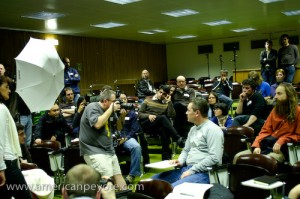 Aside from having the basic process of lighting design, the afternoon exposed us to how to “execute.” Using the seminar room, we talked about four different locations to use for portraits. Then David set about the room with umbrellas and his Orbis ringflash, photographing participants. From a certain perspective, David Hobby is like the kid who got all the toys he wanted for Christmas, and spends every day rediscovering their amazingness. This was the impression I had watching him setup the different portraits. It seemed like each light setup was like finding a rocket in the backyard and getting to set it off. This is the corner stone, getting a sense for the energy and problem solving method of the man at work – the message which I took away from the afternoon. This aspect which is more difficult to communicate on a website like Strobist, and a good reason to attend a workshop. The technical aspects are of course – trivial. Flashes are not complex, neither is lighting design, it’s how one executes the shoot which matters.
Aside from having the basic process of lighting design, the afternoon exposed us to how to “execute.” Using the seminar room, we talked about four different locations to use for portraits. Then David set about the room with umbrellas and his Orbis ringflash, photographing participants. From a certain perspective, David Hobby is like the kid who got all the toys he wanted for Christmas, and spends every day rediscovering their amazingness. This was the impression I had watching him setup the different portraits. It seemed like each light setup was like finding a rocket in the backyard and getting to set it off. This is the corner stone, getting a sense for the energy and problem solving method of the man at work – the message which I took away from the afternoon. This aspect which is more difficult to communicate on a website like Strobist, and a good reason to attend a workshop. The technical aspects are of course – trivial. Flashes are not complex, neither is lighting design, it’s how one executes the shoot which matters.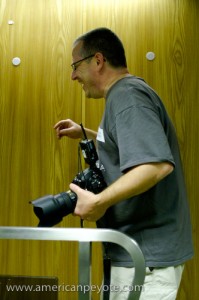 Yeahhhh, Baby. That’s what we heard every five minutes, David’s way of pulling an emotional response from his subjects. It made me think of Platon asking Bill Clinton to “Show me the Love.” By channeling Austin Powers, David pulled a smile from everyone in the room, every time he said the same line again, and again and again, it got a positive reaction. Apparently he has other lines, but since “Yeahhhhh Baby” worked every time, there wasn’t any need to bring out the reserves.
Yeahhhh, Baby. That’s what we heard every five minutes, David’s way of pulling an emotional response from his subjects. It made me think of Platon asking Bill Clinton to “Show me the Love.” By channeling Austin Powers, David pulled a smile from everyone in the room, every time he said the same line again, and again and again, it got a positive reaction. Apparently he has other lines, but since “Yeahhhhh Baby” worked every time, there wasn’t any need to bring out the reserves.
